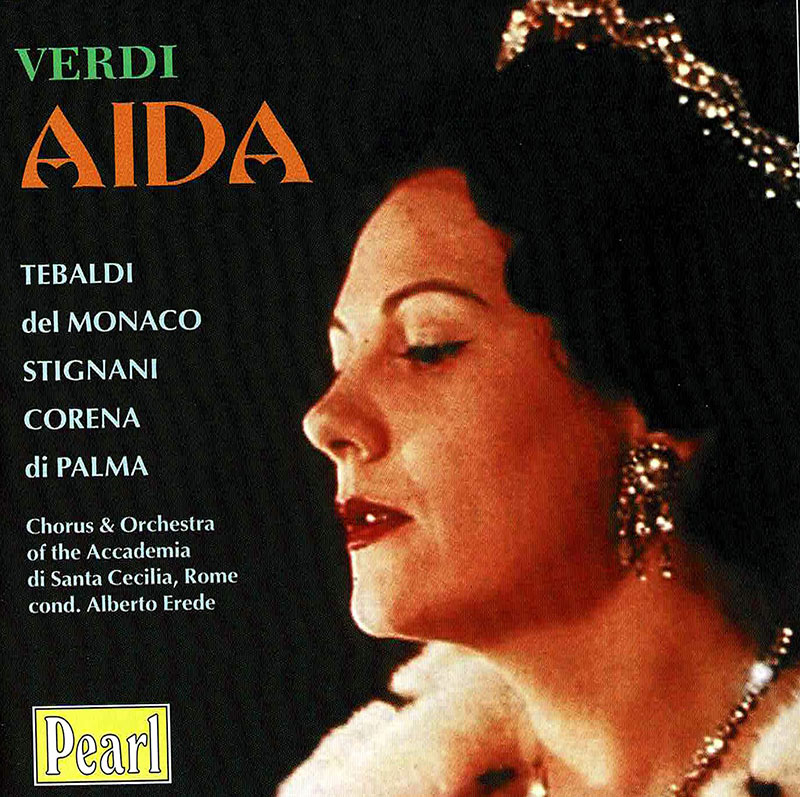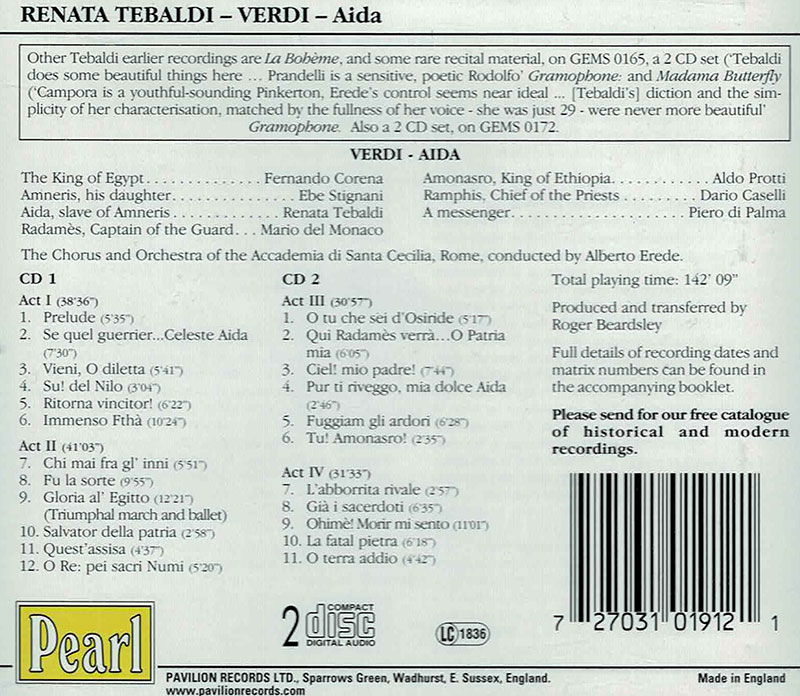Logowanie
Mikołaj - ten to ma gest!
Miles Davis, Horace Silver, Jay Jay Johnson, Percy Heath, Kenny Clarke, Lucky Thompson
Walkin'
20bit K2Super Coding - ale jak to brzmi!
Kasety magnetofonowe
Winylowy niezbędnik
ClearAudio
Double Matrix Professional - Sonic
najbardziej inteligentna i skuteczna pralka do płyt winylowych wszelkiego typu - całkowicie automatyczna
VERDI, Renata Tebaldi, Mario del Monaco, Ebe Stignani, Fernando Corena, Orchestra dell'Accademia di Santa Cecilia, Roma, Alberto Erede
Aida

RENATA TEBALDI - Aida The beginning of the LP era heralded a plethora of studio-based recordings of complete operas. Major companies hastened to secure exclusive contacts with leading artists. There were complaints from record collectors about the implications of exclusivity. Renata Tebaldi was frequently partnered by Mario del Monaco but almost never by Giuseppe di Stefano. Much later we began to realize that the commercial records also actually contained some `dream casting' not often encountered in the opera house. The three leading principals in this complete recording of Aida were widely regarded in the Italian world of opera as the leading exponents of their roles - Tebaldi as Aida; del Monaco as Radames; Ebe Stignani as Amneris. Information is never quite complete, but I have been unable so far to trace a single occasion when the three sang together in a `live' Aida or for that matter anything else. This is the third in a series of complete operas being reissued by Pearl, featuring Renata Tebaldi. Much can be read about her career in the booklets which accompany the recordings of La Boheme (GEMS 0165) and Madama Butterfly (GEMS 0172) and this is a good reason for giving rather more space on this occasion to her leading co-prindpals. However, it is worth making the point that in the first part of her careercertainly throughout the 1950s - Tebaldi was a major interpreter of Verdi as well as Puccini. She appeared in Otello, La Traviata, Falstaff Aida, Giovanna dArco, La Forza del Destino, Simon Boccanegra as well as the Requiem. In addition to some of the above, she also participated in complete recordings of Ernani, Il Trovatore and Don Carlos. Much has been made of the rivalry between Tebaldi and Callas. The latter actually sang ten different Verdi roles on stage as against Tebaldi's eight-although the total number of performances by Callas was considerably fewer. Six of the Callas Verdi operas only enjoyed a handful of performances: of these La Forza del Destino overlapped with the Tebaldi repertoire. Comparisons of Callas and Tebaldi as Verdi interpreters should really focus on La Traviata and Aida. Callas gave 58 and 31 performances respectively; comparable figures for Tebaldi were 93 and 40. Tebaldi first sang Aida at Milan's La Scala on 12 February 1950 in a cast including del Monaco and Aldo Protti as Amonasro (the role he sings in the recording). Amneris was sung by Fedora Barbieri. Three years later at the San Carlo in Naples - by which time Tebaldi had also sung Aida in San Francisco, Rio de Janeiro and Florence - Stignani was Amneris. In July that year their partnership was renewed at the Teatro Colón in Buenos Aires with Alberto Erede conducting as on the recording. A few months later Stignani was Amneris in Barcelona opposite the Radames of del Monaco. Tebaldi subsequently sang Aida in Barcelona and in a variety of American cities as well as Havana. Her last performances of the role were in Paris and Vienna in 1959. Thereafter Verdi virtually disappeared from her repertoire with one major exception - Otello. She had first appeared as Desdemona in Trieste at the end of 1945; she continued to sing the part throughout her career up to her very last appearances on the operatic stage at the Metropolitan in early 1973. Mario del Monaco's career is overdue for re-assessment. Many of his early recordings suggest a burnished, bronze voice. It must have been near ideal for the roles in which he tended to specialize for his first few years on the operatic stage - above all in the major Puccini works. By the end of 1945 he had sung in La Boheme, Madama Butterfly, Manon Lescaut and Tosca all over Italy. Nineteen Forty-Five was the year when he also took on the rather heavier role of Calaf in Turandot and that led perhaps inevitably early in 1946 to his first appearance as Radames in Trieste. La Boheme had been in his repertoire since 1941, although he never sang in it again after 1949. In 1946 he added Un Ballo in Maschera and there were further performances ofAida in Naples, Verona and Barcelona. From that time, it was to be a core part of del Monaco's repertoire. At La Scala in 1950 he sang Radames opposite both Tebaldi and Callas. The previous year he had added La Forza del Destino: now came the role with which he remains perhaps most closely associated - Otello. He would continue to appear in this opera until the end of 1972. Indeed two performances in Montreal in June 1966 were probably the last occasion on which he appeared together with Tebaldi. In addition to the above del Monaco also appeared in two other Verdi operas -11 Trovatore and Ernani. Extensive singing of such heavy roles inevitably took their toll on the natural beauty of the voice. He may have over-used it in another sense. During a tour by the San Carlo, Naples he gave no less than seven performances in Tosca at Covent Garden in September 1946 and in the middle of the run there was a single La Boheme (the night after a performance of Tosca!). The following year in Brazil he appeared in four performances of three different operas in a period of just six days - two of Madama Butterfly, one each of Mefistofele and Aida. A good many contemporary and sub-sequent evaluations sometimes suggest that del Monaco's singing style could be rather coarse and that he over-indulged in histrionics. For a far more balanced view it is worth referring to Andrew Porter's review in `Opera' of his Covent Garden performances as Otello in 1962. `(his) voice has lost its first bright, savage ring; but his Otello has gained a necessary quality that it lacked before-pathos. There is more nobility in his portrayal, and a fuller sense of word and situation. The voice is still very powerful; its darker timbre and his rather more careful use of it are hardly disadvantages, except in the first tremendous outburst He lacks tenderness; the love duet was unaffecting But his ponrayal both in phrasing and in acting has become a good deal more sensitive, and had considerable dramatic power'. Ebe Stignani was of an older generation than either Tebaldi or del Monaco. Born in 1903 she made her debut in 1925 at the San Carlo in Naples. Amneris in Aida was her third role that season. Thirty-three years later three performances of Amneris in Dublin marked her withdrawal from the operatic stage. Her most important roles, all sung throughout her career were Amneris, Azucena in 11 Trovatore and Adalgisa in Norma [GEMM CDS 94221. Stignani was a central Verdi singer for a much longer period than Tebaldi: as well as Amneris and Azucena her roles included Ulrica (Un Ballo in Maschera); Eboli (Don Carlos); Meg Page and Dame Quickly (Falstaff}; Preziosilla (La Forza delDestino); Fenena (Nabucco); Cuniza (Oberto); Maddalena (Rigoletto); and the Requiem. Stignani was a frequent visitor to the San Carlos in Lisbon. There she sang in Cavalleria Rusticana opposite del Monaco in April 1948. The two sang together in Aida in Genoa later that year and in March 1949 again in Lisbon in Un Ballo in Mascbera, whilst the following month Stignani and Tebaldi were on the roster for Falstaff. All three were in Lisbon again a year later: del Monaco joined Stignani in Aida; while Tebaldi sang with her in Rossini's Stabat Mater and further performances of Falstaff. It could have/should have been the prelude to a coming together of three of the greatest Verdi singers of their era. We should not be too critical of the Lisbon management; doubtless there were other missed opportunities in, other places. But in retrospect perhaps there was a far better case for the exclusive contract than we realized at the time. PROFESSOR STANLEY HENIG Producer's note By the time Decca came to record Aida, magnetic tape had replaced transcription-type discs as the master medium. Whilst it allowed for greater flexibility, it did have faults that are not present with the old method, dropout being the principal one. The other problem encountered is really an editing fault. Tape editing is a oneshot process: ifyou make a mistake it is not usually possible to reconstruct the tape. In 1952, tape editing was in its infancv and mistakes were common. Most of the bad edits in Aida did respond to digital techniques, but a couple or so were intractable, though now made less noticeable. The usual early Decca LP hum was there in large measure: most has been eliminated, but not to the point of affecting the sound. Why they did not hear it is a mystery, but there is a famous Decca frequency test record cut to the ffrr characteristic with hum levels that make the bottom end of the spectrum useless for testing. Also a frequent problem at this time, the LP cutting could be rather noisy in places -usually in quiet passages it seems! Steel cutting styli could be the reason although metal processing problems were still giving trouble. The original LP issue was on six sides, with each Act split over two sides. This makes for fragmented listening and is dramatically unsatisfying, so it was very fortunate that it was just possible to get the first two acts complete onto the first CD.































